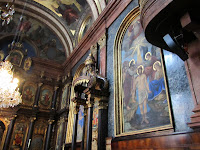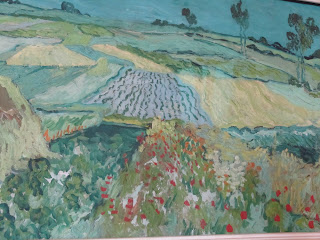"Nothing impractical can ever be beautiful."
- Otto Wagner
Today we had a tour at the Leopold Museum, the personal collection on display of Mr. and Mrs. Leopold. The museum is fairly new, housed in a specially constructed building to highlight the expressionist and Jugendstil art. Leopold began collecting art when he inherited a stamp collection from an uncle, which he then sold, making enough capital to begin purchasing art in the 1950s. Upon graduating college, he turned down an offer for a car from his parents in order to obtain a painting by Egon Schiele from London, thus beginning his long time fascination with and love for Schiele's paintings and sketches which were hardly famous at the time.
Leopold also had a strong affinity for Gustav Klimt's work - the main painting in the gallery being Death and Life (1910).

Before this particular expressionist style of painting, Klimt was associated with the art of the Ringstrasse group, embracing historicism and classical motifs. However, after three of his paintings were rejected by the University (who was responsible for the paintings' commissioning), Klimt left the Ringstrasse culture and became involved with the Secessionists, eventually becoming their president and painting Death and Life. This particular painting refers back to Klimt's unfinished painting in the Belvedere of The Bride, in both its figures and its positioning. In Death and Life, death is depicted as almost playful or sly, creeping on tip toes over to those alive. In 1915 when death was abounding amidst the unfolding drama of World War I, Klimt came back to revise this painting, adding another column of figures to contract the space between the dead and the living. In the group of the living, a mourning couple is positioned in front, while an older woman with the same coloring as death (and thus she has some association with death) is behind them. The top figures look very much alive, yet sleeping peacefully. The figures on the left, tucked in closest to death are the added figures, their open eyes forcing us and allowing us to relate to death; they are acting as the mediators between the dead and the living.
Another Secessionist who had left the culture of the Ringstrasse was the architect Otto Wagner, most famous for his Jugendstil buildings and his green Stadt Bahn stations. He famously stated and promoted the notion that the art of the past should not be copied, but that new art should be made. He championed function over form, thus rejecting the essential nature of the Ringstrasse culture.
Another room displaying furniture and artifacts collected by Leopold highlighted the Vienna workshop, co-founded by Josef Hoffman and Koloman Moser. Their main aim was to bring together artists, architects, and various other talents to provide various items accessible to the public. However, once this style became popular, the public was no longer able to obtain the items, defeating the workshop's original intent. Along with this room, Adolf Loos was also mentioned, being an architect of the mindset that when the best materials are used in a building's design and construction, there is no need for ornamentation. He thus rejected the decoration and ornate brass details embraced by the Secessionists, designing buildings 'without eyebrows'.

After this room, there were several others which highlighted artists such as Oskar Kokoschka, Richard Gerstl, and a special exhibit with many (dark and depressing) paintings and sketches by Egon Schiele.
Our tour ended in the Schiele exhibition, and was followed by a walking tour through the older part of Vienna and the Jewish quarter. The Jews have a long history in Vienna (as already explored in a previous post on the Jewish Museum), and today allowed us to see the physical places where this history was established and created.
The Jews were part of the high medieval economy, playing an integral part in the long distance trading between the Ottoman Empire and Austria after they were expelled from Spain in 1492 and settled among the Turks. In 1238 however, it became legal for Jews to live in Vienna, allowing them to build a synagogue as well. Although the Jews were legally allowed to live in Vienna and German territories, they were confined to certain area, qualifying them unofficially as ghettos. In 1420, a case of host desecration was committed in Enns, near Vienna, reverberating within the Austrian territories and leading to the mob violence against and the expulsion of the Jews from Vienna in 1421 by Duke Albrecht V (their synagogue was also destroyed at this time). There is still a plaque in the Judenplatz today which praises the pogrom of this time.

Also within the Judenplatz stands a modern memorial, taking up a large portion of the square and falling within the old boundaries of they ruined synagogue. It was built in response to the two memorials outside of the Albertina, one commemorating all those who were victims of war and fascism (dedicated to those non-Jews whose apartment was bombed) and and the other showing a Jew bound in barbed wire forced to scrub the streets. It is designed as a square library, but with all its books turned spine in, and with doors lacking knobs. This library has no access. Around the base of the library, all 41 camps where Austrian Jews were killed are listed, and there is an inscription stating
"In commemoration of more than 65,000 Austrian Jews who were killed by the Nazis between 1938 and 1945."
The books symbolize the Jews as a people of The Book, but these books - the life stories and the religion of the Jews - became inaccessible through the death inflicted by the Nazis, thus we as people can see the books, but we cannot see their titles nor their content. The Jew's contribution to the cultural intellectualism of Vienna and to the world at large is lost, and not seen - the lack of titles shows an evident cultural void.

There was a lot of dissent and disagreement among our group, with many feeling that since the inscription specified "Austrian Jews," it should have also specified that they were killed by "Austrian Nazis," their fellow citizens and countrymen. However, I don't feel that this monument aims at making a political statement, nor does it aim at pointing a finger. I believe that this monument was made for Austria, thus specifying the Austrian Jews whose lives were cut short. This monument remains ambiguous in its use of the term 'Nazi,' allowing the blame to fall on all those who declared themselves Nazis and not one specific type of Nazi. I do believe that it is important to distinguish and point out that Austrian Jews were indeed killed by their fellow Austrian Nazis, but this monument was not intended for that purpose. Rather, this monument is an appropriate commemoration of the Jews within the Austrian borders (hence the monument is IN Austria) and avoids making a political statement by refraining from engaging in the conflict between Austrians killing their fellow Austrians.
This monument does, however, fall into the area of discussion brought up by Ruth Kluger, namely, are these sorts of stereotypical images and monuments beneficial to the memory of the Holocaust, or should the images from individual stories be sufficient and be embraced over the physicality of memorials?







































 His crazy heads were made in Bratislava, however, where he had bought a house. He was rumored to be schizophrenic, and he created these heads to scare away the demons and pain he felt in the night.
His crazy heads were made in Bratislava, however, where he had bought a house. He was rumored to be schizophrenic, and he created these heads to scare away the demons and pain he felt in the night. Renoir's classical womanly figure was the epitome of beauty for the impressionists, and the landscapes depcted by both Monet and Van Gogh attempted at capturing the true essence of an experience or scene - realism was a top priority in their art. David's Napoleon Bonaparte also dominated one of the rooms, an example of the historicism which many artists desired to portray.
Renoir's classical womanly figure was the epitome of beauty for the impressionists, and the landscapes depcted by both Monet and Van Gogh attempted at capturing the true essence of an experience or scene - realism was a top priority in their art. David's Napoleon Bonaparte also dominated one of the rooms, an example of the historicism which many artists desired to portray.



